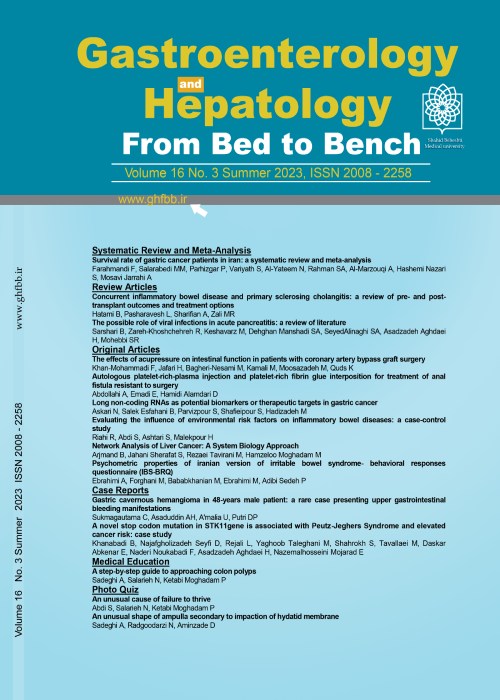Effect of Helicobacter pylori on metabolic syndrome parameters in diabetic patients
Author(s):
Abstract:
Aim: The aim of this study is to survey the effect of Helicobacter Pylori on metabolic syndrome parameters in diabetic patients.
Background
Helicobacter pylori (HP) infection is the most common infection in developing countries. Some studies showed the association between HP infection and insulin resistance. Insulin resistance is a major mechanism in the development of metabolic syndrome (MetS) and it is said that MetS is more prevalent among HP infected subjects. Also, some studies have shown that MetS is common among patients with type 2 diabetes mellitus. In this study, we aimed to investigate the prevalence of MetS in diabetic patients and its association with HP. Methods
This cross-sectional study was carried out from May to December 2014 on 211 diabetic patients. For each patient, the following data were collected: age, gender, diabetes duration, weight, body mass index (BMI), waist circumference, blood pressure (BP), HDL, cholesterol, triglyceride (TG), total cholesterol, and HbA1c. The lipid profile was performed on fasting samples. Anti- HP IgG antibody was measured and serum titer >30AU/mL was considered positive. MetS was diagnosed by The National Cholesterol Education Programs Adult Treatment Panel III report (NCEP-ATPIII) and IDF criteria.Results
Totally 139 patients (65.9%) were HP and 72 patients (34.1%) were HP-. Age, gender and diabetes duration were not significantly different in both groups. BMI was significantly lower in HP women (29.05±5.26 vs. 31.45±4.8, p=0.02). Although the waist circumference of men was not different between the two groups but it was significantly lower in HP women (102.04±12.37 vs. 97.3±10, p=0.03). Although BP and TG levels were not statistically different in HP and HP- patients, but HP patients had lower HDL level (p=0.037) which was due to lower HDL in men (58.2±26.6 vs. 72.48±28.1, p=0.012). The prevalence of MetS according to the IDF criteria among HP and HP- patients was 76.6% vs. 69.8% (p=0.27). Also, the prevalence of MetS according to NCEP-ATP III criteria among HP and HP- patients was 90.4% vs. 87.2% (p=0.5). Duration of diabetes did not affect the prevalence of metabolic syndrome among HP and HP- patients.Conclusion
It seems that HP infection increases the prevalence of metabolic syndrome through an increase in insulin resistance. According to NCEP-ATPIII criteria, the increase in the prevalence of metabolic syndrome in HP patients is almost significant, however more complete studies is recommended to investigate this relationship.Keywords:
Language:
English
Published:
Gastroenterology and Hepatology From Bed to Bench Journal, Volume:9 Issue: 4, Autumn 2016
Page:
36
magiran.com/p1627398
دانلود و مطالعه متن این مقاله با یکی از روشهای زیر امکان پذیر است:
اشتراک شخصی
با عضویت و پرداخت آنلاین حق اشتراک یکساله به مبلغ 1,390,000ريال میتوانید 70 عنوان مطلب دانلود کنید!
اشتراک سازمانی
به کتابخانه دانشگاه یا محل کار خود پیشنهاد کنید تا اشتراک سازمانی این پایگاه را برای دسترسی نامحدود همه کاربران به متن مطالب تهیه نمایند!
توجه!
- حق عضویت دریافتی صرف حمایت از نشریات عضو و نگهداری، تکمیل و توسعه مگیران میشود.
- پرداخت حق اشتراک و دانلود مقالات اجازه بازنشر آن در سایر رسانههای چاپی و دیجیتال را به کاربر نمیدهد.
In order to view content subscription is required
Personal subscription
Subscribe magiran.com for 70 € euros via PayPal and download 70 articles during a year.
Organization subscription
Please contact us to subscribe your university or library for unlimited access!


